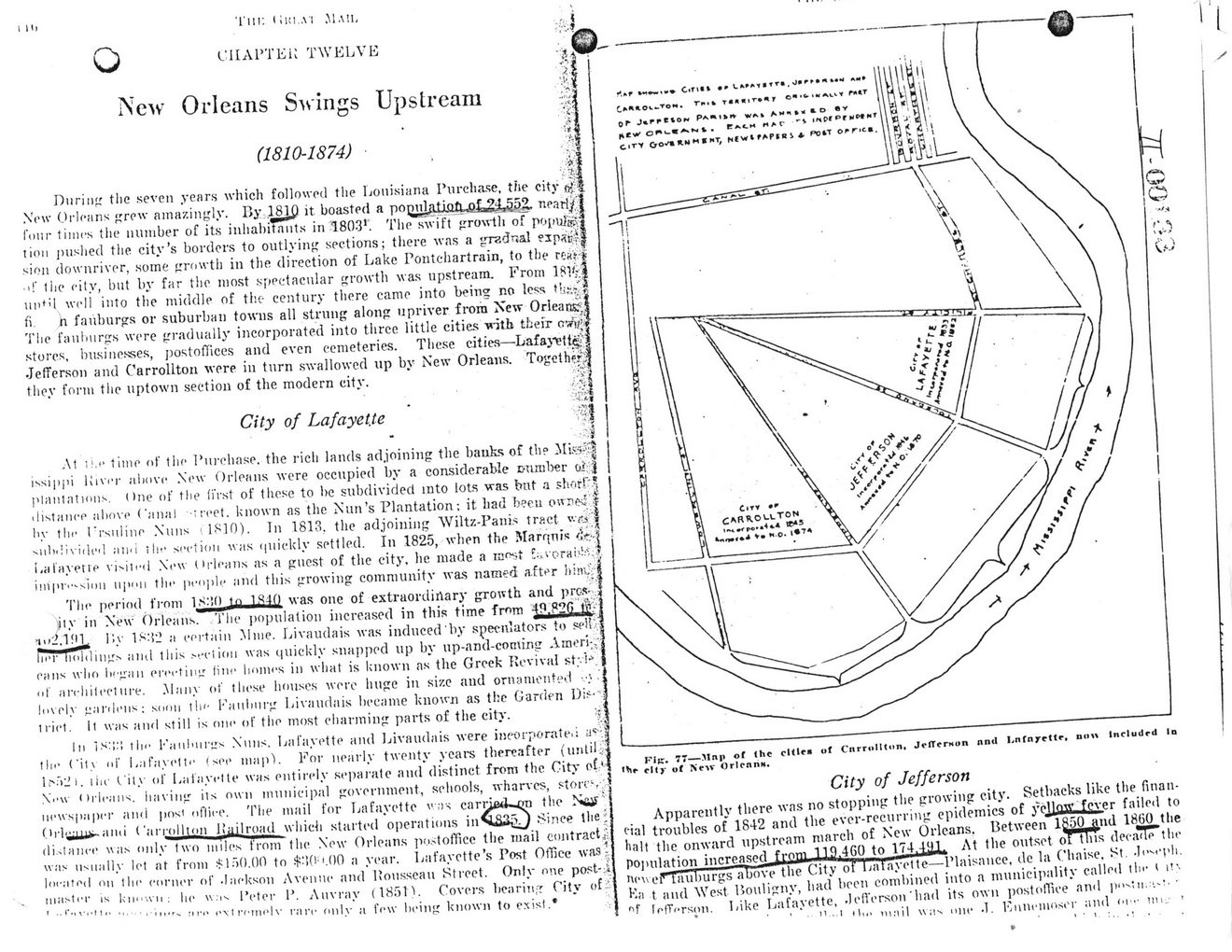This text was obtained via automated optical character recognition.
It has not been edited and may therefore contain several errors.
o 'I'm: Cm..vi Mail CHAPTER TWELVE New Orleans Swings Upstream (1810-1874) During the seven years which followed the Louisiana Purchase, the city of New Orleans grew amazingly. By 1810 it boasted a potTnlfitiofi -^£^4^552. nearijf: four times the number of its inhabitants in 18031. The swift growth of popuI(£ tion pushed the city’s borders to outlying sections; there was a gradual ?3p«Ey| sion downriver, some growth in the direction of Lake Pontchartrain, to the •if the cilv, but by far the most spectacular growth was upstream. From 18V;. unf’l well into the middle of the century there came into being no less fi n faiiburgs or suburban towns all strung along upriver from Xew Orleans^ The fauburgs were gradually incorporated into three little cities ■witb their ovfift stores, businesses, postofTices and even cemeteries. These cities—Lafayette Jefferson and Carrollton were in turn swallowed up by New Orleans. Together^ they form the uptown section of the modern city. :'£.j City of Lafayette 1 At ti.e time of the Purchase, the rich lands adjoining the banks of the Mis?-::| issippi liner above New Orleans Mere occupied by a considerable E-uml>er ol;| plantations. One of the (i’rst of these to be subdivided into lots was but a shot!'?, distance above Canal -treet. known as the Nun’s Plantation; it had been owned by the I'rsuline Nuns (ISIO). In 1813, the adjoining Wiltz-Panis tract v-'ajr| subdivided ami the section was quickly settled. In 1825, when the Marqnis Lalayerre visited New Orleans as a guest of the city, he made a most E:*vorai>!*..$ implosion upon th** people and this growing community was named after binCi" The period from was one of extraordinary growth and pros- J ijty in New Orleans. The population increased in this time from It1-' •n>2.1 f’L 1>.V a certain Mine. Livaudais was induced by speculators to sei’> lier Holdings and this itm was quickly snapped lip by up-and-coming Ameri£ cans who began erecting line homes in what is known as the Greek Revival sty!*, nt architect lire. Many of these houses were huge in size and ornamented ■■} • lovely gardens; soon the Fatiburg Livaudais became known as the Garden District. It was and still is one of the most charming parts of the city. <f In the Kanburgs Nuns. Lafayette and Livaudais were incorporate.; iis- the (‘it \ of Lafayette (see map'). For nearly twenty years thereafter (until*; InVJ i. iin- City of Lafayette was entirely separate and distinct from the City of*. New Orleans, having its own municipal government, schools, wharves, stores.! newspaper and post oflice. The mail for Lafayette vas carned-^ni the (irle.-nis-Miiii (started operations inVl£Sp-_) Since the' distance was only two miles from the New Orleans postofficc the mail contract j; was usually lot at from $ 150.00 to .^lO' >.00 a year. Lafayette's Post Office was?, loeated <m the corner of Jackson Avenue and Rousseau Street. Only one post-:.* master is known: he w.is Peter P. Auvray (18511. Covers bearing City of; -'Ii’e e\irernelv rare onlv a few being known to exist.* ■ vl 1 i. City of Jefferson Apparently there was no stopping the growing city. Setbacks like the financial troubles of 1842 and the ever-recurring epidemics of vellow fever failed to halt the onward upstream march of New Orleans. Between 1850and 18(K^tlie Population increased from 119.460 to 174.49J. At the outset oMThs deca'le the newertauburgsabove the City of Lafayette—Plaisance, de la Chaise, St. Joseph. Ha t and West Boulignv, had been combined into a municipality called the t n\ telTerson. Like Lafayette, Jefferson had its own postollice and postit. • 1 ,lu> mail was one J. EnUcinnser and or- im: ' » ' « . ’ . .

New Orleans and Louisiana Document (038)